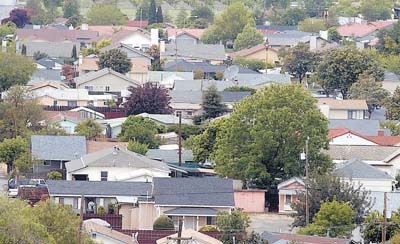There were another 249 San Benito County homes entering some
stage of the foreclosure process last month, a 207 percent jump
over the same period in 2007, according to recently released data
from Irvine-based RealtyTrac.
There were another 249 San Benito County homes entering some stage of the foreclosure process last month, a 207 percent jump over the same period in 2007, according to recently released data from Irvine-based RealtyTrac.
That astounding number also represents a 62 percent increase over the previous month, as nearly 100 fewer homes entered the list of foreclosures in July, according to the data.
As a whole, the figures show there are 1,053 local homeowners whose properties have been sent a letter of default, put up for auction by a lender or passed outright into bank ownership. It gives San Benito County the seventh-worst foreclosure rate among California’s 58 counties.
The rate of foreclosures has accelerated dramatically statewide, with increases over last year’s August numbers ranging from 13 percent in Sacramento County to an increase of 2,340 percent in Lake County, according to RealtyTrac.
Many locals already have lost their homes. Nearly half of the county properties now in foreclosure – 473 – are owned by the banks, said Hollister Code Enforcement Officer Mike Chambless.
C.J. Valenzuela, the housing programs coordinator with San Benito County, has been examining the growing problem closely and said it is impossible to tell if we have hit the bottom.
“I work with local agencies, community groups, businesses, and I do a lot of research,” said Valenzuela, “and I know that there has been a huge negative effect on this community. There are safety and health issues dealt with by the code enforcement office, financial issues the lenders are experiencing, abandoned swimming pools monitored with vector control … countless effects.”
Valenzuela believes that the current crisis is a result of poor lending practices and a lack of financial literacy.
“Foreclosures are a symptom – the disease is that lenders had guidelines that were too flexible, and homebuyers weren’t educated in tough financial matters enough,” he said.
Enrique Arreola is also familiar with the effects foreclosure rates have on San Benito County as deputy director of community services and work force development.
“We have seen an increase in residents coming in for all kinds of services,” he said, adding that the increase is due to many factors of the current economic downturn, with foreclosures being an important contributor.
“Foreclosure is a direct contributor in the stability of our economy, and the current instability has people coming in here more frequently looking for (Pacific Gas & Electric) payment help, employment assistance you name it.”
There is some hope on the horizon as a result of local and state politicians try to gather relief funds for people being slammed by foreclosure.
“Our redevelopment agency has a first-time homeowner program,” said Hollister Mayor Doug Emerson. “The idea is to get those first-timers, and get them into one of those empty houses by giving them help with the down payment.”
Emerson added that there is $500,000 earmarked for the program and that each borrower would receive $25,000 with 1 percent interest.
Then there are Community Development Block Grants. These grants are issued by The United States Department of Housing, often known as HUD, which fund local development activities such as affordable housing and anti-poverty programs. Valenzuela said his office has been applying for the grants while investigating the effects of foreclosures on the community.
“We want to be ready to help people immediately if we get the grants,” he said, adding that the funds would be used in a variety of ways to keep people out of foreclosure.
One of those ways is through financial education of prospective homebuyers – and current homeowners. Valenzuela and Arreola’s agencies are combining to provide just such an education.
“We are trying to get housing workshops on foreclosures, financial stability, finding reasonable loans and so on,” said Arreola.
Valenzuela noted that the first workshop is 9:30 a.m. Saturday at the Veterans Memorial Building – call 636-1763 to sign up – and that it will provide a step-by-step guide to acquiring a house without eventually losing it.
“The real-estate market goes through cycles,” Valenzuela pointed out. “We are somewhere in the process of a difficult cycle now, but there is an upside.
“We can start with the many affordable homes on the market, where people get a good home on a good 30-year fixed loan. We’ll get these foreclosures off the books and start a new cycle.”










